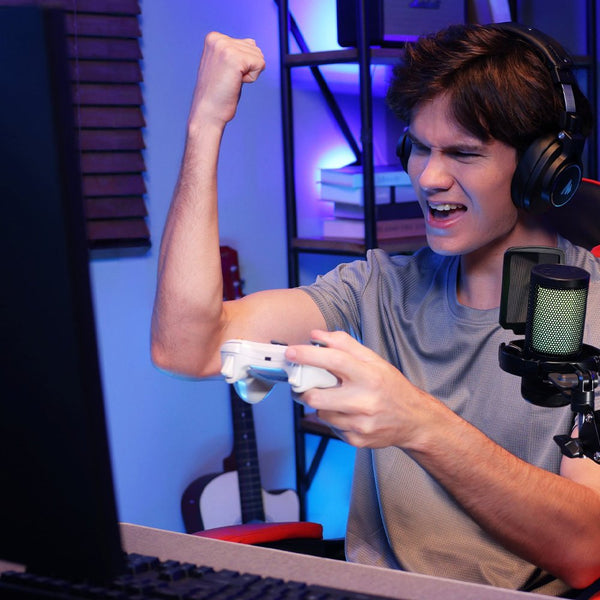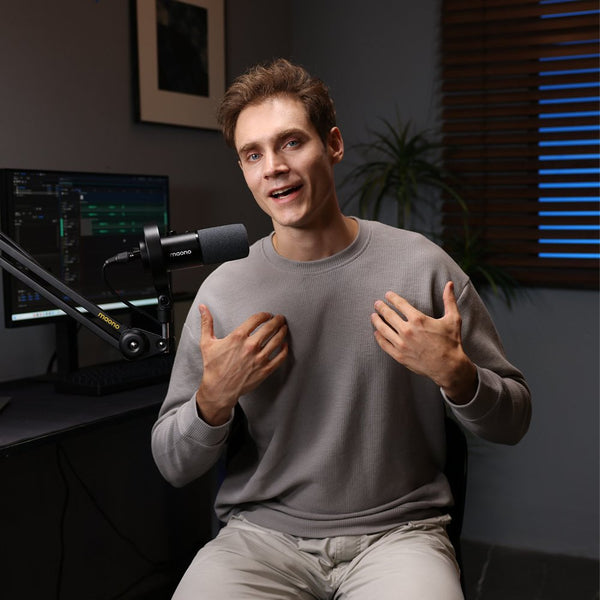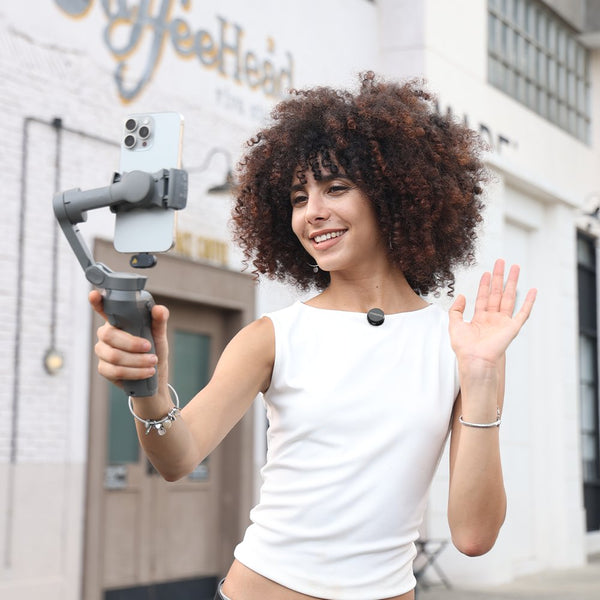Are you on a calorie deficit? If so, have you heard of or come across the term "calorie cycling"? Let’s find out more.
When it comes to fat loss, most people are familiar with the concept of a calorie deficit—eating fewer calories than you burn; but there’s a more flexible and potentially more sustainable method gaining popularity: calorie cycling.
If you’re just starting your fitness journey or hitting a plateau, calorie cycling might be the smarter approach to help you stay consistent, maintain muscle, and still enjoy your favorite foods in moderation. Also, if you're documenting your fitness journey on video, pairing this strategy with clear wireless microphone audio—like the Maono Wave T5—can help you build an authentic and professional vlog series.
In this guide, we’ll explore calorie cycling, how to use it effectively, and how to clearly communicate your progress on camera with pro-level sound.

Calorie Cycling vs Traditional Calorie Deficit: Which Is Better?
The traditional approach to fat loss involves maintaining a consistent daily calorie deficit. While this method is straightforward and effective, it can feel restrictive and tough to stick to long term.
Calorie cycling, on the other hand, alternates high-calorie and low-calorie days throughout the week. This helps support intense workouts on high days and provides a psychological break from constant restriction.
Differences:
-
Traditional Deficit: Same low-calorie goal daily; great for beginners.
-
Calorie Cycling: Varies daily intake; better for energy management and plateaus.
The best option depends on your goals, mindset, and activity levels. However, for many people, calorie cycling offers a more dynamic and forgiving path to fat loss.
How to Use Calorie Cycling for Sustainable Weight Loss
At its core, calorie cycling still respects the law of thermodynamics—you need to burn more calories than you consume over time. But rather than cutting every single day, you might alternate days like this:
-
High-Calorie Days: Higher carb and calorie intake (for workout or leg days).
-
Low-Calorie Days: Reduced intake to create the deficit (rest or light days).
Example Weekly Plan:
|
Day |
Intake |
Notes |
|
Monday |
Low (1,600 kcal) |
Rest day |
|
Tuesday |
High (2,100 kcal) |
Strength training |
|
Wednesday |
Low |
Cardio/light day |
|
Thursday |
High |
Lifting day |
|
Friday |
Low |
Rest or light cardio |
|
Saturday |
Moderate |
Active social day |
|
Sunday |
High |
Long run/hike |
This gives your body recovery fuel and reduces the mental fatigue that often comes with dieting. It's especially useful for preserving muscle mass during a cut.
How to Speak Clearly About Macros, Cravings & Progress on Camera
When you’re vlogging your weight loss journey, it’s not just what you say—but how clearly your viewers can hear you. If your voice gets drowned out by background noise or echoes, your message won’t stick.
Tips for clear communication:
-
Write short scripts or bullet points ahead of time.
-
Use natural language when explaining macros and calorie changes.
-
Speak slowly and clearly, especially if you’re outdoors or cooking.
-
Use a microphone lavalier wireless system like the Maono Wave T5 to capture crisp voice audio no matter where you are.
Your audience wants to relate to your experience, so clear, authentic delivery builds trust.
Pairing Calorie Cycling with Training: What to Track & How to Vlog It
To maximize your fat loss while retaining muscle, you'll want to pair your eating strategy with thoughtful training.
What to Track:
-
Calories & Macros: Use MyFitnessPal or a similar app.
-
Weight & Measurements: Track weekly, not daily.
-
Workout Performance: Are you lifting heavier or feeling stronger?
-
Mood & Hunger Levels: Helps with adjusting your cycle schedule.
How to Vlog It:
-
Film 30-second daily updates using your lapel mic clipped to your shirt.
-
Show meal prep, gym clips, or screen recordings of your food log.
-
Keep updates honest—talk about tough days and wins.
Recording doesn’t require a full production. With a lapel mic wireless setup, even your casual clips can sound podcast-worthy.
Documenting Fat Loss Progress: Audio Tips for Fitness Vloggers
Your viewers can overlook shaky video or bad lighting—but poor sound is a dealbreaker. That’s why fitness vloggers should invest in good lapel mics early on.
Top Audio Tips:
-
Use a lavalier (clip-on) mic for hands-free filming.
-
Record indoors or in quiet areas when possible.
-
For voiceovers, hold the mic steady or attach it to your shirt.
-
Windy outdoors? Use a foam windscreen to cut interference.
-
Avoid clothing rustle by securely clipping the mic.
The Maono Wave T5 wireless microphone is perfect for this setup. Let’s look at why it’s a favorite among creators.
Why Choose the Maono Wave T5 Wireless Microphone for Fitness Vlogs?
When you're filming everything from gym sessions to food prep or voice overs while walking, the Maono Wave T5 checks all the boxes:
✅ Notable Features:
-
Dual-transmitter system – Record yourself and a guest simultaneously (great for collaborations).
-
Lavalier design – Clip-on and discreet, perfect for workouts or daily vlogging.
-
Long battery life – Up to 9 hours of use for extended shooting days.
-
Noise reduction – Filters out background sounds for clear, crisp dialogue.
-
Plug-and-play – Connects easily via USB-C, Lightning, or 3.5mm jack.
-
Compact and portable – Pocket-sized receiver and transmitter make it perfect for mobile setups.
Whether you're filming a food tutorial or narrating your walk to the gym, the Maono Wave T5 captures your voice naturally, letting your content shine.
Maono Wave T5 User Review:
FAQs:
Here are some common questions people want to know about calorie cycling:
What exactly is calorie cycling and how does it work?
Calorie cycling is a dietary strategy that alternates between high- and low-calorie days to match energy needs, support recovery, and avoid diet fatigue.
Is calorie cycling more effective than a regular calorie deficit?
It can be for some people. It allows flexibility, supports intense workouts, and helps preserve muscle—all while maintaining an overall calorie deficit.
How do I calculate high and low calorie days for fat loss?
Use a TDEE (Total Daily Energy Expenditure) calculator. Subtract 10–20% for your weekly deficit and distribute calories higher on training days and lower on rest days.
Can calorie cycling help me break through a weight loss plateau?
Yes. Shifting your calorie intake pattern can reignite fat loss, especially if your body has adapted to a consistent deficit.
What are examples of calorie cycling schedules for beginners?
Start with 3 high-calorie days (training), 4 low days (rest/cardio). Adjust based on hunger, energy, and results.
Is calorie cycling safe for women or people with hormonal issues?
Generally, yes—but consult a doctor or dietitian if you have hormonal imbalances or medical conditions. Women may respond better to more moderate fluctuations.
Should I change my macros on high vs low calorie days?
Yes. On high days, increase carbs to fuel workouts. On low days, focus on protein and fat for satiety.
Can I still lose weight if I mess up one of my cycling days?
Absolutely. One day won’t ruin progress. Stay consistent across the week and adjust if needed.
How do I pair calorie cycling with workout intensity or rest days?
Plan high-calorie days for strength training and low-calorie days for cardio or rest. This ensures energy availability when you need it most.
Is calorie cycling good for muscle retention while dieting?
Yes, especially when paired with resistance training and adequate protein. High days help refuel glycogen and support recovery.
Vlogging Calorie Deficit & Progress with a Wireless Mic
How can I film updates about my calorie cycling without background noise?
Use a professional lavalier microphone like the Maono Wave T5 wireless mic with noise cancellation. Film in quiet areas and keep the mic close to your mouth.
How do I record voice-over reflections while walking or exercising?
Clip your mic to your shirt and use a phone gimbal for stability. The T5’s portability makes it perfect for this.
What are some easy script ideas for tracking calorie deficit progress on camera?
-
“Here’s what I ate on my low-calorie day.”
-
“Check out how I adjust my macros after leg day.”
-
“This is how I handle cravings on high-calorie days.”
Can I record my voice with a wireless mic while showing food logs or MyFitnessPal?
Yes! Sync the mic to your phone or camera, then record a voice-over as you scroll through your log or screen-record your app.
What mistakes should I avoid when using a wireless mic for fitness vlogging?
-
Forgetting to charge the mic
-
Not using a windscreen outdoors
-
Clipping the mic too far from your mouth
-
Wearing clothes that rustle loudly
What’s the best budget lapel mic for tracking fitness and food vlogs?
The Maono Wave T5 stands out thanks to its noise filtering, dual recording, and ease of use. It’s ideal for documenting real-life fat loss journeys with professional sound.
Conclusion
Calorie cycling gives you flexibility, helps manage hunger, and supports training while still promoting fat loss. Whether you’re overcoming a plateau or just looking for a smarter, more forgiving way to shed pounds, this strategy can work wonders.
But it’s not just about what you eat—it’s how you share your story. With a lapel mic wireless like the Maono Wave T5, your audience hears your voice clearly, without distractions, making your vlogs more engaging and credible.
Track your meals. Share your wins. Reflect honestly. And always keep the audio crisp—because in the world of fitness content, your voice matters as much as your vision.



